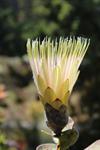
Protea flowers are bisexual. That is, both male and female reproductive parts are found in the same flower. The flowers are irregular, with many arranged in heads which are usually sessile. Heads are solitary, and flowers are enclosed in involucres of variously coloured, imbricate bracts. The fruit is a densely bearded nut. It is the colourful bracts that are very showy – the flowers themselves are generally insignificant.
CLASSIFYING PROTEAS
Proteas can be classified in many different ways – the following example
classifies them according to flower size:
A. Large flowers- includes:
P. cynaroides, P. magnifica.
B. Flowers large, but longer than
their diameter - includes:
P. compacta, P. laurifolia,
P. nerifolia, P. grandicepa.
C. Flowers closed and pointed-
includes: Protea repens.
D. Small flowers- includes:
P. susanne, P. nana.
Other ways of classifying them might be according to their indigenous location (e.g. tropical species and temperate climate species), or according to botanical similarities.
CULTURAL NEEDS
Proteas grow best in soil which is well-drained and low in nutrients (i.e. sandy type soils such as sandy loams). Wet soils can result in root rot problems, especially from Phytophthora cinnamomi (cinnamon fungus).
 Soil
Soil
- A soil pH of 5.5 is the preferred average (range 4.4 6.5), although some varieties tolerate a higher pH.
- It should be low in phosphorus and salt - this is known as a “hungry” soil.
- It is essential that drainage is good. Temperature & General Conditions
- Frost most varieties will tolerate temperatures down to minus 4°C. Many varieties will tolerate temperatures as low as minus 8°C. However, protection from extreme cold might be needed, particularly for young plants. Damaged shoots need to be cut back after the danger of frosts is over.
- Temperatures up to 40°C are tolerated. Hot northerly winds can scorch some varieties.
- Humidity is unacceptable - except where there is a good wind movement.
- Full sun is preferred, but shade in late afternoon is tolerated.
- Good air movement is essential to keep plants well-ventilated.
- Soil around plants should not be cultivated – avoid root disturbance.
- Plants need good rains in the winter - during the summer most varieties will survive in fairly dry conditions.
Fertiliser
- No fertilisers should be used when specimens are planted in the field - except in rare circumstances.
- If the pH is above 5.5 or 6, an iron deficiency can occur which may be overcome by either lowering the pH or feeding with iron chelate (even rusty iron nails will supply iron to a plant effectively, but slower than iron chelate).
- Animal manures and organic fertilisers such as blood and bone should be avoided.
- If chemical fertilisers are used, they should contain only very limited amounts of phosphorus since all members of the Proteaceae family are naturally adapted to growing in soils with low phosphorus levels.
This is an extract from our ebook "
Proteas and their Relatives" .